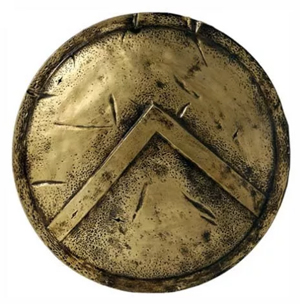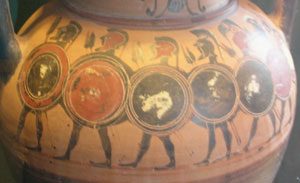
Ancient Greek soldiers – Greek hoplites in a phalanx formation (Chigi Vase, ca. 650 BC)
Before the hoplite phalanx
In the Bronze Age, and in the early part of the Archaic period, Greek soldiers fought their battles the same way most other soldiers did in the Mediterranean and West Asia. They learned to fight as individuals. Some rich men fought in horse-drawn chariots.
Where did horses come from?
Invention of the wheel
The Greek Bronze Age
All our ancient Greece articles
Most men fought on foot, carrying a spear and a shield, or a bow and arrow. The shields were made of wood. They had decorations painted on them to show who you were.
More about bows and arrows
Sometimes ancient Greek shields had a thin layer of bronze over the wood. When a battle started, the soldiers ran towards each other independently and chose someone to fight.
New kinds of Greek soldiers
About 650 BC, Greek generals in various different city-states came up with a new way of fighting battles that gave Greek soldiers of the Archaic period a big advantage over the soldiers of other countries like Egypt or the Lydians.
More about Egyptian warfare
What is a city-state?
Archaic Greece

Ancient Greek soldiers: A Spartan hoplite shield, with the lamba of Lacedaimonians on it
Instead of fighting all in a big crowd, running forward and just trying to get at the enemy any which way, Greek generals trained their soldiers to fight in lines, shoulder to shoulder.
In this way each man (Greek men didn’t let women be soldiers) was protected by the shield of the man standing next to him. When they all marched forward together, no enemy spears or arrows could get through their wall of shields.
If the people you were fighting were still using the old methods, you could win most of your battles. And you could win battles even when there were a lot more of them than there were of you.
(More about bows and arrows)
The Greek hoplite phalanx

Greek soldiers marching
Greek people called a soldier who fought this way a hoplite (HOP-light), and they called a group of soldiers who fought this way a hoplite phalanx (FAY-lanks).A hoplite phalanx was a very strong military formation – but it only worked if all the soldiers were well trained, and if they were all brave enough to hold the line.
If anyone started to run away, the whole line would fall apart, and it wouldn’t work. Or, if some men went slower than others, or got out of step, it wouldn’t work. So hoplites needed to spend a lot of time training, just the way people today train to be in a marching band. They got that time by making enslaved people do a lot of their farm work and making things, so they would have time to practice fighting.
Slavery in ancient Greece

Spartan hoplite soldier
Like a marching band, Greek hoplite soldiers had to learn to all walk forward at the same speed, staying together – even when the enemy was shooting arrows at them and piercing them with spears! They had to learn to turn right or left all together, too, without messing up the shield wall that protected them. Musicians walked alongside the soldiers, playing drums or pipes to help keep the men in step with each other.
More about ancient Greek music
Greek hoplites win the Persian Wars
The first big war where the Greeks had a chance to really try out the hoplite phalanx was when the Persians invaded Greece in 490 BC. They were pretty nervous about it. These were the Persians! They had a great army that had already defeated lots of other armies! Would the new hoplite phalanx even work against the Persian army?
But at the Battle of Marathon, facing the Persian army, the Athenians stuck to their training, and they did win the battle! That showed that a well-trained hoplite phalanx could beat even very experienced, highly trained Persian soldiers who were still fighting in the old way. Hoplite warfare really worked!
More about the Battle of Marathon
Classical Greek history
Did you learn what you wanted to about Greek soldiers and the Greek hoplite phalanx? Let us know in the comments!
Learn by doing: a Greek shield
Greek hoplites and democracy
And more about the Persian Wars
More about the Peloponnesian War
Bibliography and further reading about Greek military methods, weapons, and armor:
Greek Hoplite (Soldier Through the Ages), by Martin Windrow (1985). , from Scholastic.
Greek Hoplite 480-323 BC, by Nicholas Sekunda (2000). From Britain. A good first guide, useful for painting models or illustrating reports.
Warfare in the Classical World: An Illustrated Encyclopedia of Weapons, Warriors and Warfare in the Ancient Civilisations of Greece and Rome, by John Warry. Lots of pictures, and not too much text.
Greece and Rome at War, by Peter Connolly (1998). Not too hard.
Hoplites: The Classical Greek Battle Experience, edited by Victor Davis Hanson (reprinted 1993). Essays by different specialists, more or less accessible to interested and confident readers. The writers don’t discuss strategy and tactics so much as the experience of the actual individual soldier.





THIS IS AMAZING I HAVE BIG BRAIN NOW
This is a good website and i really recommend it for later projects!I have been looking at it for an assignment in school and its really helping!Good Job!
Thank you, Rion! If you could recommend that your school or your teacher links to us, that would help us reach more students!
what did the greek army fight with during the persian wars
Like, what kind of weapons? That’s in the article.
this is boring
Sorry! I guess I think men killing each other by poking holes in each other with spears is awful, but not exactly boring?
its preetyy umfy
I LOVE THIS WEBSITE ITS SO HELPFUL THANKS!!!
I’m glad you like it, Ryan! If you want to help out, you could ask your teacher or librarian to link to us; that would help other students to find this site.
this stuff is pretty ugly and cool
ikr